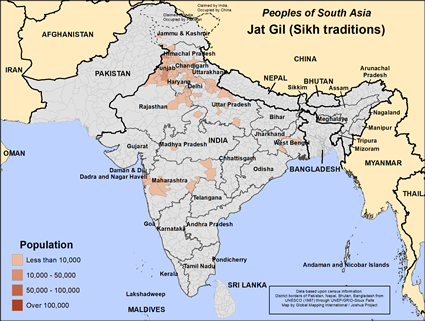Jat Gil (Sikh traditions) in India

Photo Source:
Anonymous
|

Map Source:
People Group data: Omid. Map geography: UNESCO / GMI. Map Design: Joshua Project.
|
| People Name: | Jat Gil (Sikh traditions) |
| Country: | India |
| 10/40 Window: | Yes |
| Population: | 250,000 |
| World Population: | 250,000 |
| Primary Language: | Punjabi, Eastern |
| Primary Religion: | Other / Small |
| Christian Adherents: | 0.00 % |
| Evangelicals: | 0.00 % |
| Scripture: | Complete Bible |
| Ministry Resources: | Yes |
| Jesus Film: | Yes |
| Audio Recordings: | Yes |
| People Cluster: | South Asia Sikh - Jat |
| Affinity Bloc: | South Asian Peoples |
| Progress Level: |
|
Introduction / History
Hollywood is a familiar name in the Western world for being the center of the entertainment and film industry, but throughout most of South Asia, the entertainment hub is nicknamed "Bollywood," centered in Mumbai. A name that crops up time and again in Bollywood is the surname Shergill. A number of Shergills are prominent in India's entertainment industry.
The Shergill name comes from the Gill Jat clan, mostly from India's Punjab State. The Gill Jat clan is found in the Punjab regions straddling eastern Pakistan and northwestern India. It is one of the largest and most aristocratic of the Jat clans. Historically they were renowned for their courage, honesty and bravery. During the British control of India, Sir Lepal Griffin said that "The Jat race is, for honesty, strength, and courage, second to no race on earth."
What Are Their Lives Like?
Overall, Jat Gils have a good self-image. "Men may come and men may go, but I go on forever," is a well-known Jat proverb. They are brave, hardworking people who possess both the desire and ability to rule. It has been said that no Jat wants to be ruled. Rather, he desires to have power over a group if not over an area. They take great pride in their ancestry. In fact, all the Jats in a particular village consider themselves to be the descendants of the man whom they believe founded it by the power of the sword. Traditionally Jats have dominated as the political class in Haryana and Punjab.
Conservative by nature, Jat Gils rarely marry people from other people groups. From about 1650 AD onwards marrying within same gotra (i.e., lineage or community) became more common. The modern-day litmus test that Jat people use in marriage is if the girl and boy must not have the same great-great-grandparents (not related for four generations). If they are from the same gotra but are not directly related for four generations then it is considered acceptable for them to marry.
Physically, Jat Gils are usually taller and heavier than most of their neighbors. Because of their larger build, their reputation for violence, and the fact that they control much of the land and village income, they are generally feared by other communities in South Asia.
Most Jat Gils live in rural areas, and they are usually landowners. A small percentage are traders and laborers. Today, Jat Gils are well read, and some occupy high positions in academic and technical arenas. The Jat peoples are one of the most prosperous groups in India on a per-capita basis (Punjab, Haryana, and Gujarat are the wealthiest of Indian states). Haryana has the largest number of rural crorepatis (similar to "millionaires") in India, all of whom are Jats.
What Are Their Beliefs?
Of all three major Jat religious groups, the Sikhs are the most powerful and prominent in India. A number of Jat people belonging to the political classes have produced many political leaders, including the 6th Prime Minister of India, Prime Minister Chaudhary Charan Singh.
Until recent times, the Jat Sikhs seemed to be the least meticulous in their observance of Sikh traditions. Sikh Jats observe many ceremonies, especially rites of passage such as initiation into adulthood. Wedding ceremonies are especially important to Jat Sikhs.
During the wedding ceremony, Sikhs make a square enclosure known as Chaonari and perform a fire sacrifice. The couple walks seven times around the Chaonari with their right hand inward. A Jat Sikh cannot take a wife from his own section. Widow remarriage is allowed but she cannot marry her younger brother-in-law or the near relatives of her deceased husband.
What Are Their Needs?
In every people group, there are pioneers ready to break with culture and tradition and explore something new. TV and film might be just such a venue for the gospel message.
Prayer Points
Pray for God to anoint and appoint workers to create relevant, culturally sensitive Christ-centered radio, TV, and films that will be appropriate for the Gill Sikhs of India.
Pray for the Jat Gils, especially those who work in the entertainment industry, to see their need for Jesus Christ.